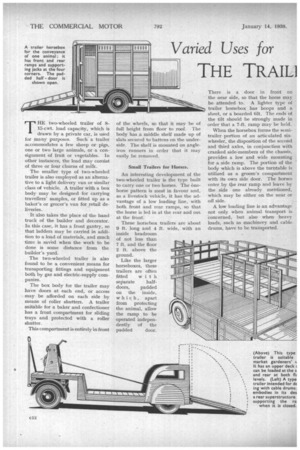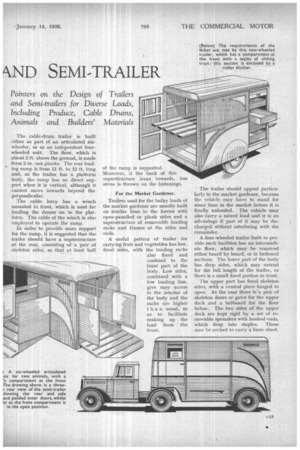Varied Uses for
Page 10

Page 11

If you've noticed an error in this article please click here to report it so we can fix it.
THE TRAIL]
okl\ID SEMI-TRAILER Pointers on the Design of Trailers and Semi-trailers for Diverse Loads, Including Produce, Cable Drums, Animals and Builders' Materials THE two-wheeled trailer of 815-cwt. load capacity, which is drawn by a private car, is used for many purposes. Such a trailer accommodates a few sheep or pigs, one or two large animals, or a consignment of fruit or vegetables. In other instances, the load may consist of three or four churns of milk.
The smaller type of two-wheeled trailer is also employed as an alternative to a light delivery van or similar class of vehicle. A trailer with a box body may be designed for carrying travellers' samples, or fitted up as a baker's or grocer's van for retail deliveries.
It also takes the place of the hand truck of the builder and decorator. In this case, it has a front gantry, so that ladders may be carried in addition to a load of materials, and much time is saved when the work to be done is some distance from the builder's yard.
The two-wheeled trailer is also found to be a convenient means for transporting fittings and equipment both by gas and electric-supply companies.
The box body for the trailer may have doors at each end, or access may be afforded on each side by means of roller shutters. A trailer suitable for a baker and confectioner has a front compartment for sliding trays and protected with a roller shutter.
This compartment is entirely in front of the wheels, so that it may be of full height from floor to roof. . The body has a middle shelf made up of slats secured to battens on the underside. The shelf is mounted on angleiron runners in order that it may easily be removed.
Small Trailers for Horses.
An interesting development of the two-wheeled trailer is the type built to carry one or two horses. The onehorse pattern is most in favour and, as a livestock vehicle, it has the advantage of a low loading line, with both front and rear ramps, so that the horse is fed in at the rear and out at the front.
These horsebox trailers are about 9 ft. long arid 4 ft. wide, with an inside headroom of not less than 7 ft. and the floor 2 ft. above the ground.
Like the larger horseboxes, these trailers are often fitted with separate half doors, padded on the inside, which, apart from protecting the animal, allow the ramp to be operated independently of the padded door.
There is a door in front on the near side, so that the horse may be attended to. A lighter type of trailer horsebox has hoops and a sheet, or a boarded tilt. The ends of the tilt should be strongly made in order that a 7-ft. ramp may be held.
When the horsebox forms the semitrailer portion of an articulated sixwheeler, the disposition of the second and third axles, in conjunction with cranked side-members of the chassis, provides a low and wide mounting for a side ramp. The portion of the body which is above the turntable i3 utilized as a groom's compartment with its own side door. The horses enter by the rear ramp and leave by the side one already mentioned, which may be either on the near or off side.
A low loading line is an advantage not only when animal transport is Concerned, but also when -heavy loads, such as machinery and cable drums, have to be transported.
The cable-drum trailer is built either as part of an articulated sixwheeler, or as an independent fourwheeled unit. The floor, which is about 2 ft. above the ground, is made from 2-in, oak planks. The rear loading ramp is from 11 ft. to 12 ft. long and, as the trailer has a platform body, the ramp has no direct support when it is vertical, although it cannot move inwards beyond the perpendicular.
The cable lorry has a winch mounted in front, which is used for hauling the drums on to the platform. The cable of the winch is also employed to operate the ramp.
In order to provide more support for the ramp, it is suggested that the trailer should have a superstructure at the rear, consisting of a pair of skeleton sides, so that at least half of the ramp is supported. Moreover, if the back of this superstructure leans inwards, less stress is thrown on the fastenings.
For the Market Gardener.
Trailers used for the bulky loads of the market gardener are usually built on similar lines to the lorries with open-panelled or plank sides and a superstructure of removable loading racks and frames at the sides and ends.
A useful pattern of trailer for carrying fruit and vegetables has low, fixed sides, with the loading racks also fixed and confined to the front part of the body. Low sides, combined with a low loading line, give easy access to the interior of the body and the racks are higher th an usual, so as to facilitate making up the load from the front, The trailer should appeal particularly to the market gardener, because the vehicle may have to stand for some time in the market before it is finally unloaded. The vehicle may also carry a mixed load and it is an advantage if part of it may be discharged without interfering with the remainder.
A four-wheeled trailer built to provide such facilities has an intermediate floor, which may be removed either board by board, or in battened sections. The lower part of the body has drop sides, which may extend for the full length of the trailer, or there is a small fixed portion in front.
The upper part has fixed skeleton sides, with a central piece hinged to open. At the rear there is .a pair of skeleton doors or gates for the upper deck and a tailboard for the floor below. • The two sides of the upper deck are kept rigid by a set of removable spreaders with hooked ends, which drop into staples. These may be arched to carry .a loose sheet.


































